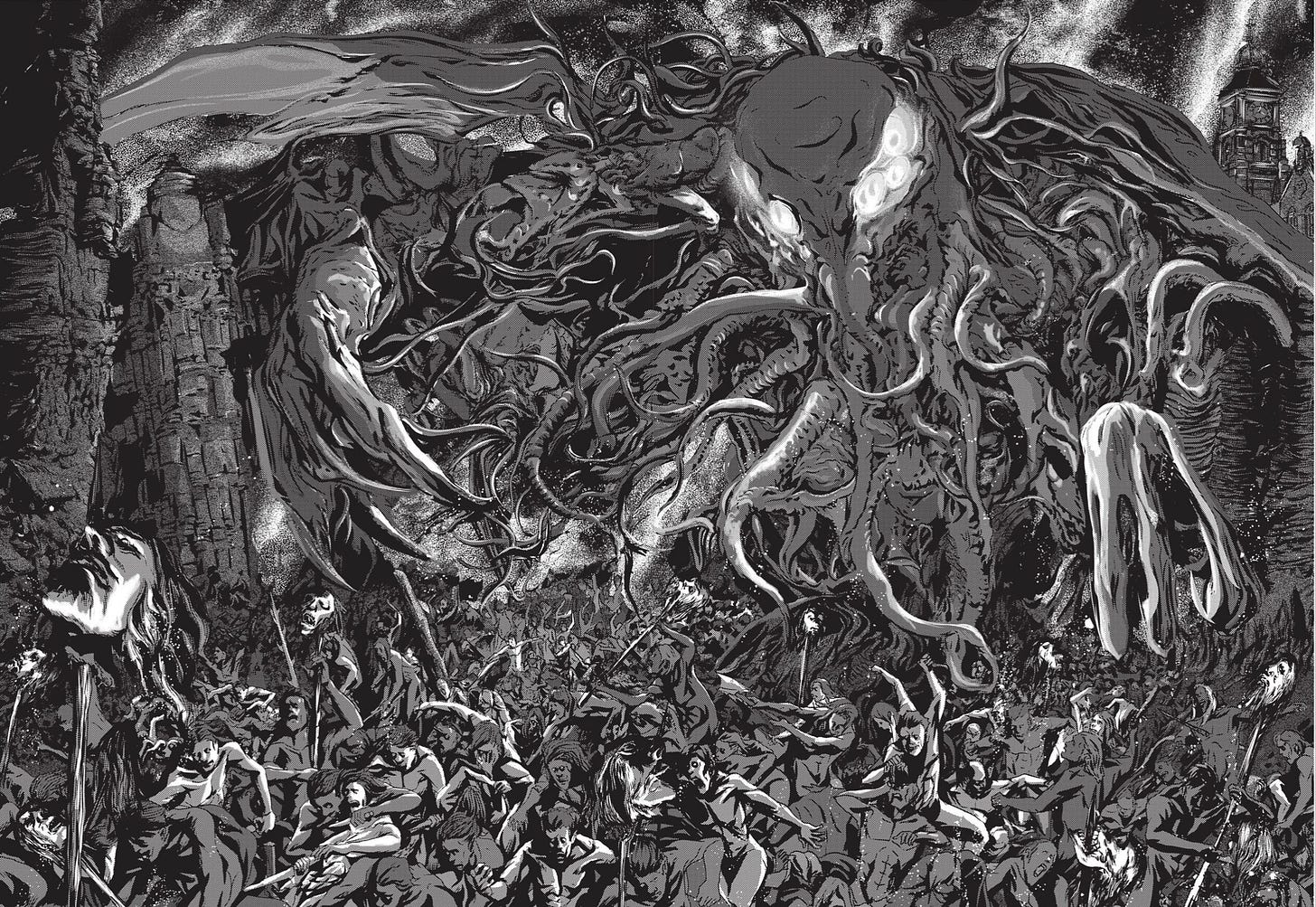Eldritch Etchings
Gou Tanabe's Lovecraft Adaptations
World War II unleashed manifold horrors, some of which have not yet returned to Pandora’s box. Thankfully, not all of the horrors were of flesh and blood. One—the legacy of H.P. Lovecraft—is made of ink and paper. In 1945, the U.S. Armed Forces reprinted Arkham House’s 1939 volume, The Dunwich Horror and Other Weird Tales, as an Armed Services Edition volume. This meant that U.S. troops could enjoy Cthulhu and other Old Ones during downtime on Uncle Sam’s dime. This was a massive departure from what Lovecraft experienced while still alive. The “pulp hack” who died with more pen-pals than respect suddenly found himself being read by doughboy privates and battled-hardened sergeants. Maybe even a furtive lieutenant or two worked up the gumption to listen to the music of Eric Zann…
Across the Pacific, Japan found Lovecraft around the same time. Nishio Tadashi translated Lovecraft’s “The Statement of Randolph Carter” for the magazine, Hakaba (“Graveyard”) in the 1940s. Following this, legendary Japanese mystery writer Edogawa Ranpo likewise showered Lovecraft with respect, naming him one of the vital writers of the Occidental weird tale. This was a signal for Japanese translators, some of whom took up the task of translating Lovecraft after the war. Since the 1980s, Japan has been a source of incredible Lovecraft-themed content, especially in regards to manga.

Lovecraftian manga is today more or less synonymous with the work of Junji Ito (1963- ). Ito is without question the best-known horror manga-ka in the Anglophone world, and his following is similarly massive in his native Japan. Ito’s original work combines the sensibilities of Weird Tales magazine with body horror and the gore-soaked brand of giallo that has been a staple in the Far East for decades. Ito’s Uzumaki (“Spiral”) and Gyo (“Fish”) reek of the putrefaction of Lovecraft’s mythos. They are highly weird, somewhat transgressive tales about a small town plagued by an obsession with spirals, and a Unit 731 experiment in biological warfare that turned virus-ridden animals into walking death machines. Ito short story collections showcase a similar style, which is both recognizably Lovecraftian and also all his own.
Another manga-ka working with the weird is Gou Tanabe (1975- ). Tanabe was already a well-established manga artist when he stumbled across Lovecraft. According to a French-language interview with CNews2, Tanabe discovered Lovecraft’s writing during an unproductive period in his life. After wading through the stories, Tanabe felt drawn to the feelings of hopelessness exuded by characters in stories like “The Call of Cthulhu,” “Dagon,” and others. This appreciation for cosmicism inspired Tanabe to start inking his own interpretations of Lovecraft’s work. His first attempt, a manga adaptation of “The Outsider,” proved successful enough that Tanabe began focusing on more adaptations.
It took decades, but now Tanabe work is finally available and is receiving praise from English-language readers and critics alike. Dark Horse Comics published the first English translation of his work in 2017. This volume, H.P. Lovecraft’s The Hound and Other Stories, was nominated for an Eisner Award at the San Diego Comic-Con in 2018. Two years later, Tanabe’s two-volume adaptation of At the Mountains of Madness, received another Eisner nomination as well as a nomination for the New York Comic-Con’s Harvey Award. Tanabe’s latest release, H.P. Lovecraft’s The Shadow Over Innsmouth, which was originally published in Japan in 2021, is currently a best-seller on Amazon. One assumes that Tanabe shall receive yet another nomination (nominations?) for his flawless adaptation of arguably Lovecraft’s most seminal tale.

As with all of his other adaptations of Lovecraft’s work, Tanabe’s take on The Shadow Over Innsmouth involves a heavy use of dark colors and chiaroscuro. Innsmouth in particular is depicted much like the fictional village of Holstenwall in The Cabinet of Dr. Caligari—hoary roofs on top of odd-shaped houses that dot a landscape that does not conform to Euclidian geometry. The horror inside of Innsmouth, I.e., its residents, are drawn as disgusting, more-fish-than-human beasts that shamble and never blink. The one nod to beauty is the main character and narrator, who is depicted as a handsome and blonde waif. Of course that changes by the manga’s conclusion, and Tanabe really excels at depicting not only the horrific character of the Deep Ones, but also the blasphemous majesty of their underwater cities. The only blemish here is the weird use of bad computer-generated art that separates Chapter Five from Chapter Six. Such mid-1990s-tier abominations mar this moody masterpiece.
All four of Tanabe’s English-language books are worth your time. Tanabe is a maestro whose work, while far more Western than most of his manga-ka compatriots, nevertheless remains solidly Japanese. Conversely, Tanabe’s adaptations are faithful, and Lovecraftian obsessives will have a hard time complaining about anything insofar as these books are concerned. One would be hard-pressed to find a better gift for the tentacle enthusiast in your life, and if they complain, just remind that weeaboo that Tanabe is from the Land of the Rising Sun. That should shut their yap.

